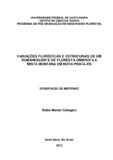| dc.creator | Callegaro, Rafael Marian | |
| dc.date.accessioned | 2017-02-15 | |
| dc.date.available | 2017-02-15 | |
| dc.date.issued | 2012-02-24 | |
| dc.identifier.citation | CALLEGARO, Rafael Marian. STRUCTURAL AND FLORISTIC VARIATIONS IN A REMNANT OF
MONTANE MIXED OMBROPHYLOUS FOREST IN NOVA PRATA-RS. 2012. 97 f. Dissertação (Mestrado em Recursos Florestais e Engenharia Florestal) - Universidade Federal de Santa Maria, Santa Maria, 2012. | por |
| dc.identifier.uri | http://repositorio.ufsm.br/handle/1/8695 | |
| dc.description.abstract | This work aimed to analyze floristic and structure variations in a Montane Mixed Ombrophylous Forest remnant, in the county of Nova Prata, RS. It was inventoried
71 parcels with dimensions of 10 x 100 m, using the process of systematic sampling in Two Stages. It were identified and measured all individuals with circumference at
breast height ≥ 30,0 cm. The dissertation was divided into two chapters, with specific objectives to analyze the presence of floristic groups (Chapter I) and diagnostic and
diagnose structural variations between clusters (Chapter II). The plots were classified by cluster analysis, using the Ward connection method. The plots were classified into
four distinct floristic groups that present differences in specific diversity, composition and floristic similarity. The group 3 included the largest area of forest remaining and it had the highest diversity values and species number between groups, and greater floristic similarity with the forest in general. It was observed that different species
dominate ecological groups in relation to the structure, favoring the development of specific populations. The aggregate (clustered) distribution pattern was the main
pattern of spatial distribution of species obtained in the groups, indicating that the species forming denser spots in the vegetation. The diameter and hypsometric structures proved to be different between groups indicating they have good capacity for renewal and a denser canopy bottom. In summary, the floristic groups of the Montane Mixed Ombrophylous Forest remnant had floristic and structural variations. These variations evidence the need to consider different arboreous communities in the case of an intervention. | eng |
| dc.description.sponsorship | Conselho Nacional de Desenvolvimento Científico e Tecnológico | |
| dc.format | application/pdf | por |
| dc.language | por | por |
| dc.publisher | Universidade Federal de Santa Maria | por |
| dc.rights | Acesso Aberto | por |
| dc.subject | Floresta com araucária | por |
| dc.subject | Análise de agrupamento | por |
| dc.subject | Fitossociologia | por |
| dc.subject | Composição específica | por |
| dc.subject | Heterogeneidade estrutural | por |
| dc.subject | Forest with araucaria | eng |
| dc.subject | Cluster analysis | eng |
| dc.subject | Phytosociology | eng |
| dc.subject | Specific composition | eng |
| dc.subject | Structural heterogeneity | eng |
| dc.title | Variações florísticas e estruturais de um
remanescente de floresta ombrófila mista montana
em Nova Prata - RS | por |
| dc.title.alternative | Structural and floristic variations in a remnant of
montane mixed ombrophylous forest in Nova Prata -RS | eng |
| dc.type | Dissertação | por |
| dc.description.resumo | O presente trabalho teve como objetivo geral analisar as variações florísticas e estruturais de um remanescente de Floresta Ombrófila Mista Montana, localizado no
município de Nova Prata, RS. Para isso, foram inventariadas 71 parcelas, com dimensões de 10 x 100 m, pelo processo de Amostragem Sistemática em Dois Estágios. Foram identificados e mensurados todos os indivíduos com circunferência
à altura do peito ≥ 30,0 cm. A dissertação foi dividida em dois capítulos, com os objetivos específicos de analisar a presença de grupos florísticos (Capítulo I) e diagnosticar variações estruturais entre os agrupamentos (Capítulo II). Por meio da análise de agrupamento, utilizando o método de ligação Ward, as parcelas foram classificadas em quatro grupos florísticos distintos, que apresentam diferenças de diversidade específica, composição e similaridade florística. O Grupo 3, que englobou a maior área do remanescente florestal, possui os maiores valores de
diversidade e número de espécies entre os grupos, e a maior similaridade florística com a floresta em geral. Em relação à estrutura, constatou-se que diferentes espécies dominam ecologicamente os grupos, favorecendo o desenvolvimento de
populações específicas. O principal padrão de distribuição espacial das espécies nos grupos obtidos foi o agregado (agrupado), indicando que as espécies ocorrem formando manchas mais densas na vegetação. As estruturas diamétrica e
hipsométrica mostraram-se distintas entre os grupos, e indicam que estes possuem boa capacidade de renovação e um dossel inferior mais denso. Em síntese, os grupos florísticos do remanescente de Floresta Ombrófila Mista Montana
apresentam variações florísticas e estruturais, as quais evidenciam a necessidade de se considerar as diferentes comunidades arbóreas no caso de uma intervenção. | por |
| dc.contributor.advisor1 | Longhi, Solon Jonas | |
| dc.contributor.advisor1Lattes | http://buscatextual.cnpq.br/buscatextual/visualizacv.do?id=K4787435E5 | por |
| dc.contributor.referee1 | Boligon, Alexandra Augusti | |
| dc.contributor.referee1Lattes | http://buscatextual.cnpq.br/buscatextual/visualizacv.do?id=K4221434U8 | por |
| dc.contributor.referee2 | Vaccaro, Sandro | |
| dc.contributor.referee2Lattes | http://buscatextual.cnpq.br/buscatextual/visualizacv.do?id=K4723997J2 | por |
| dc.creator.Lattes | http://lattes.cnpq.br/1845160765609404 | por |
| dc.publisher.country | BR | por |
| dc.publisher.department | Recursos Florestais e Engenharia Florestal | por |
| dc.publisher.initials | UFSM | por |
| dc.publisher.program | Programa de Pós-Graduação em Engenharia Florestal | por |
| dc.subject.cnpq | CNPQ::CIENCIAS AGRARIAS::RECURSOS FLORESTAIS E ENGENHARIA FLORESTAL | por |


